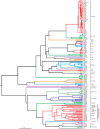Molecular inferences suggest multiple host shifts of rabies viruses from bats to mesocarnivores in Arizona during 2001-2009
- PMID: 22737076
- PMCID: PMC3380930
- DOI: 10.1371/journal.ppat.1002786
Molecular inferences suggest multiple host shifts of rabies viruses from bats to mesocarnivores in Arizona during 2001-2009
Abstract
In nature, rabies virus (RABV; genus Lyssavirus, family Rhabdoviridae) represents an assemblage of phylogenetic lineages, associated with specific mammalian host species. Although it is generally accepted that RABV evolved originally in bats and further shifted to carnivores, mechanisms of such host shifts are poorly understood, and examples are rarely present in surveillance data. Outbreaks in carnivores caused by a RABV variant, associated with big brown bats, occurred repeatedly during 2001-2009 in the Flagstaff area of Arizona. After each outbreak, extensive control campaigns were undertaken, with no reports of further rabies cases in carnivores for the next several years. However, questions remained whether all outbreaks were caused by a single introduction and further perpetuation of bat RABV in carnivore populations, or each outbreak was caused by an independent introduction of a bat virus. Another question of concern was related to adaptive changes in the RABV genome associated with host shifts. To address these questions, we sequenced and analyzed 66 complete and 20 nearly complete RABV genomes, including those from the Flagstaff area and other similar outbreaks in carnivores, caused by bat RABVs, and representatives of the major RABV lineages circulating in North America and worldwide. Phylogenetic analysis demonstrated that each Flagstaff outbreak was caused by an independent introduction of bat RABV into populations of carnivores. Positive selection analysis confirmed the absence of post-shift changes in RABV genes. In contrast, convergent evolution analysis demonstrated several amino acids in the N, P, G and L proteins, which might be significant for pre-adaptation of bat viruses to cause effective infection in carnivores. The substitution S/T₂₄₂ in the viral glycoprotein is of particular merit, as a similar substitution was suggested for pathogenicity of Nishigahara RABV strain. Roles of the amino acid changes, detected in our study, require additional investigations, using reverse genetics and other approaches.
Conflict of interest statement
The authors have declared that no competing interests exist.
Figures



Similar articles
-
Multidisciplinary approach to epizootiology and pathogenesis of bat rabies viruses in the United States.Zoonoses Public Health. 2013 Feb;60(1):46-57. doi: 10.1111/zph.12019. Epub 2012 Nov 9. Zoonoses Public Health. 2013. PMID: 23137052
-
Reemergence of a Big Brown Bat Lyssavirus rabies Variant in Striped Skunks in Flagstaff, Arizona, USA, 2021-2023.Vector Borne Zoonotic Dis. 2024 Aug;24(8):552-562. doi: 10.1089/vbz.2023.0126. Epub 2024 May 22. Vector Borne Zoonotic Dis. 2024. PMID: 38775097
-
A permanent host shift of rabies virus from Chiroptera to Carnivora associated with recombination.Sci Rep. 2017 Mar 21;7(1):289. doi: 10.1038/s41598-017-00395-2. Sci Rep. 2017. PMID: 28325933 Free PMC article.
-
The lyssavirus host-specificity conundrum-rabies virus-the exception not the rule.Curr Opin Virol. 2018 Feb;28:68-73. doi: 10.1016/j.coviro.2017.11.007. Epub 2017 Nov 25. Curr Opin Virol. 2018. PMID: 29182939 Review.
-
Oral vaccination of wildlife against rabies: opportunities and challenges in prevention and control.Dev Biol (Basel). 2004;119:173-84. Dev Biol (Basel). 2004. PMID: 15742629 Review.
Cited by
-
Connecting the study of wild influenza with the potential for pandemic disease.Infect Genet Evol. 2013 Jul;17:162-87. doi: 10.1016/j.meegid.2013.02.020. Epub 2013 Mar 26. Infect Genet Evol. 2013. PMID: 23541413 Free PMC article. Review.
-
Evaluation of species identification and rabies virus characterization among bat rabies cases in the United States.J Am Vet Med Assoc. 2020 Jan 1;256(1):77-84. doi: 10.2460/javma.256.1.77. J Am Vet Med Assoc. 2020. PMID: 31841089 Free PMC article.
-
Rabies in Costa Rica - Next Steps Towards Controlling Bat-Borne Rabies After its Elimination in Dogs.Yale J Biol Med. 2021 Jun 30;94(2):311-329. eCollection 2021 Jun. Yale J Biol Med. 2021. PMID: 34211351 Free PMC article. Review.
-
Geographic Distribution of Rabies Virus and Genomic Sequence Alignment of Wild and Vaccine Strains, Kenya.Emerg Infect Dis. 2024 Aug;30(8):1642-1650. doi: 10.3201/eid3008.230876. Emerg Infect Dis. 2024. PMID: 39043404 Free PMC article.
-
The history of rabies in the Western Hemisphere.Antiviral Res. 2017 Oct;146:221-232. doi: 10.1016/j.antiviral.2017.03.013. Epub 2017 Mar 29. Antiviral Res. 2017. PMID: 28365457 Free PMC article.
References
-
- Nadin-Davis SA, Real LA. Molecular phylogenetics of the lyssaviruses - insights from a coalescent approach. Adv Virus Res. 2011;79:203–238. - PubMed
-
- Kuzmin IV, Rupprecht CE. Bat rabies. In: Jackson AC, Wunner WH, editors. Rabies, 2nd ed. Academic Press; 2007. pp. 259–307.
-
- Rupprecht CE, Turmelle A, Kuzmin IV. A perspective on lyssavirus emergence and perpetuation. Curr Opin Virol. 2011;1:662–670. - PubMed
-
- Velasco-Villa A, Orciari LA, Souza V, Juárez-Islas V, Gomez-Sierra M, et al. Molecular epizootiology of rabies associated with terrestrial carnivores in Mexico. Virus Res. 2005;111:13–27. - PubMed
Publication types
MeSH terms
Substances
LinkOut - more resources
Full Text Sources
Medical

